
Original Link: https://www.anandtech.com/show/730
Socket-A & Socket-370 Cooler Roundup - March 2001
by Tillmann Steinbrecher on March 7, 2001 2:28 AM EST- Posted in
- Cases/Cooling/PSUs
Since our last Socket A cooler roundup, several new and highly interesting coolers have been introduced. More manufacturers are now using copper for their heatsinks - either for an inlay, for the base plate, or for the entire cooler. The days where overclockers had to chose between only two or three cooler models are long over; today a wide variety of high performance coolers are available. Given the fast pace of the cooling market, it was clearly time for a new Socket cooler roundup.
This cooler roundup is the first cooler test where our new testing methodology is being used; the results are now more accurate and therefore small differences between coolers with similar performance have become more obvious. Details about the methodology can be found in our new Heatsink Guide documenting AnandTech's new Testing Methodology.
We have re-tested the 8 most efficient fan/heatsink combinations from our last cooler roundup with the new testing methodology. For individual articles about these coolers, please see our Socket-A & Socket-370 Cooler Roundup from November of last year.
Additionally, we have also tested the Alpha PAL35 with a 7000rpm Delta fan, at the request of AnandTech readers.
Here are the results of the performance test:
Test With CPU Simulator - Temperature Readings
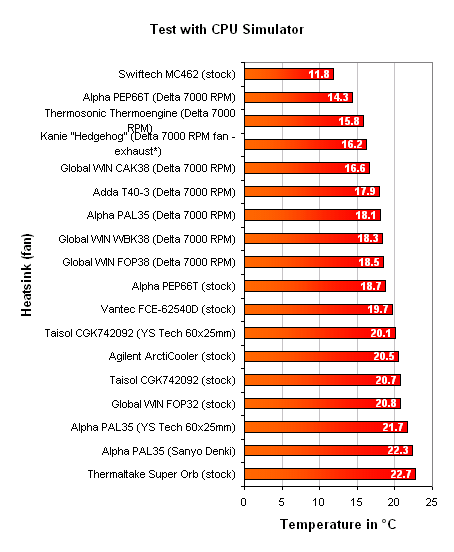
Temperatures measured above are temperature differences between the simulator
temperature and the ambient air temperature
(exhaust) means the fan exhausts air from the heatsink
"stock fan" means manufacturer-supplied fan
Test With a Real CPU - Temperature Readings
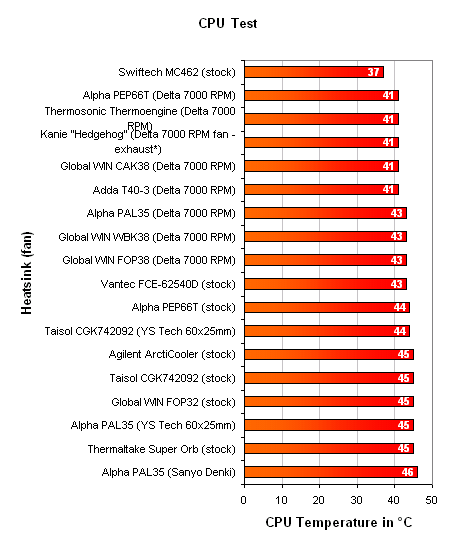
Motherboard temperature: 31°C, Ambient temperature: 19°C
Unfortunately, the Thermaltake Volcano II and the Thermaltake Mini Super Orb did not arrive in time for the test. They will be included in the next update; as well as the Swiftech MC370.
Here are the results of the fan air speed test:
Fan Performance Measurements - Fan Air Speed
Since many of the coolers tested here use the same fans, we
only show each fan model once here.
The Thermaltake SuperOrb's fans cannot be measured with our test setup, since
they are embedded into the heatsink.
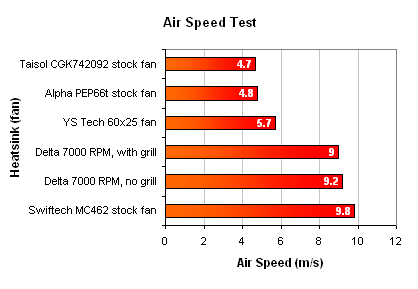
We're measuring air speed, not air throughput. Therefore the value from an 80mm fan, as the one on the Swiftech MC462, cannot be directly compared to a 60mm fan.
We now also measure cooler noise. For details on the test, please have a look a the new testing methodology article.
Cooler noise - measurements
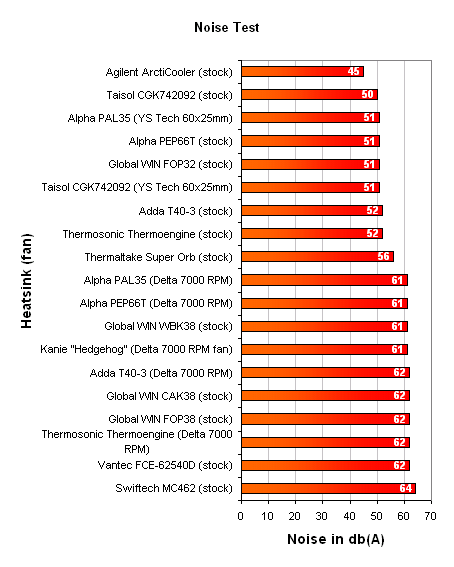
Swiftech MC462
The Swiftech MC462 is definitely the most impressive cooler we've ever reviewed
- size, design and performance are extraordinary. The cooler's base plate is
80x80mm big and consists of copper. The aluminum pins are inserted into the
base plate.
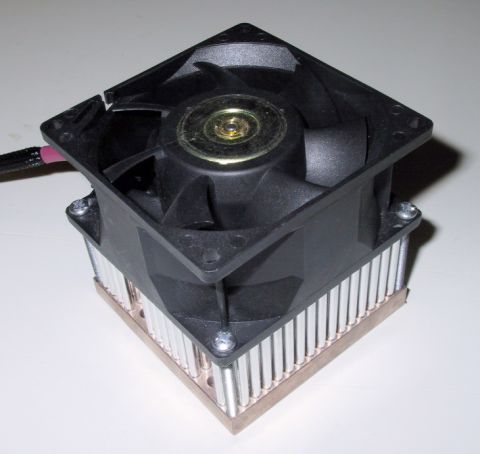
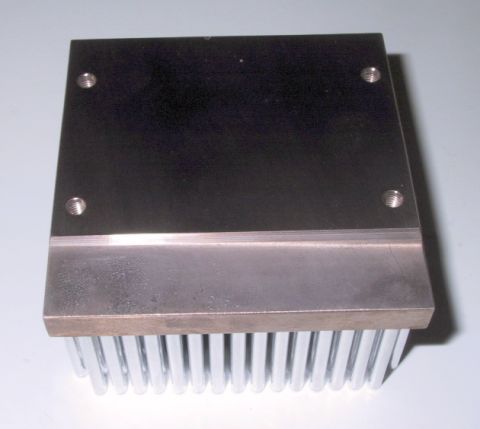
View from below. Note that there is no clip - the MC462 is installed using
screws that fit through the four holes around the CPU socket, which are
present on all Socket A motherboards.
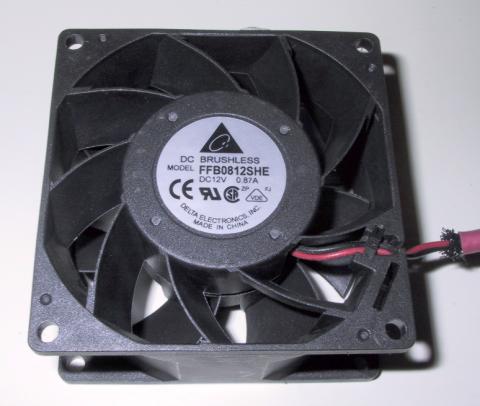
The MC462's 80x80x38mm Delta fan. Interesting detail: Above the rotating
fan blades, there is a second set of fixed blades. These redirect the air
, so that there is a right angle between fan and the direction of the air
flow - this improves air circulation within the heatsink.
Performance and noise
The MC462's performance is absolutely convincing. At this time, it is by far the most efficient CPU cooler available (unless we consider watercoolers and similar setups). Note that with the current setup, we have only tested with a 43W heat load; with higher thermal loads, the performance advantage of the MC462 over its competitors should become even more obvious.
A problem with all super-efficient coolers is noise. This is also true for the MC462 - in its standard configuration, it is also the loudest cooler in this roundup. However, Swiftech has done something about this problem: They offer an optional rheostat that allows users to adjust fan speed, by lowering the voltage supplied to the fan. This way, users can find the noise/performance compromise that is most suitable for their needs. The fan speed can be adjusted from 3000rpm to 4900rpm. Even when the fan is spinning only at 2/3 of its maximum speed, the MC462 will still outperform its competitors. The rheostat does not provide automatic temperature control though; it only runs the fan at a lower, but constant speed.
Installation
The MC462 doesn't use the hooks on the CPU socket for installation - instead, it is mounted with screws; it takes advantage of the four holes around the CPU socket, which are found on all Socket A motherboards.
Therefore, installation is quite time-consuming; if you are upgrading from an older cooler, you will have to uninstall your entire motherboard in order to install the MC462. However, this is worth the trouble. The MC462's mounting method is definitely superior; it presses the cooler to the CPU very firmly, and even though the cooler is extremely heavy (790 grams, which exceeds the AMD specifications), there is no risk of damaging the CPU or motherboard when moving around the PC.
Even though installation takes some time, it is easy to do and well-documented by the manufacturer. Due to its huge size, the cooler might not fit all Socket A motherboards on the market; it does fit the Abit KT7, Asus A7V and their successors without problems, though.
The MC462's fan is equipped with a power supply connector, and therefore cannot be connected directly to the motherboard. This is good, because the fan's high power usage might damage the fan connectors of some boards. The downside, however, is that RPM monitoring isn't possible.
| Swiftech MC462 |
|
Fan:
Delta 80x80x38mm
Fan
rpm: 4900 (Mfr spec, rpm monitoring not supported)
Price: $79.95 |
| Advantages |
|
| Disadvantages |
|
Alpha PEP66T
The PEP66T is an improved version of Alpha's well-known PEP66, which we reviewed some months ago. The differences between PEP66 and PEP66T are the base plate and the fan. The PEP66T is compatible both with Socket A and Socket 370 CPUs.
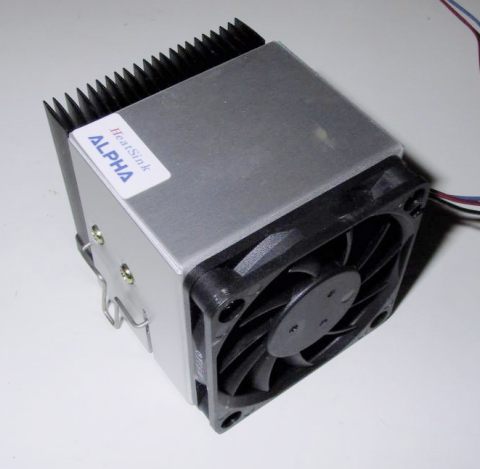
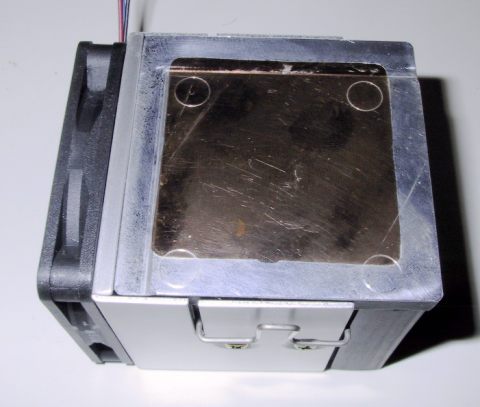
Copper inlays aren't anything special anymore - but Alpha was the first
manufacturer to use this technology.
Performance
The PEP66T's performance is very good. Equipped with the standard 60x60x10mm Delta fan, it provides a good compromise between performance and noise, and it fits all motherboards.
With a 7000rpm Delta fan (used, for example, on the Global WIN FOP38), the
PEP66T's performance is even better; in this configuration, it is only outperformed
by the huge Swiftech MC462. However, it does not fit some Socket A motherboards
when used with a 60x60x25mm fan; in particular, it is incompatible with the
Abit KT7. It fits the Asus A7V, though.
Installation
Installation is straightforward; the cooler is installed using a wire clip. Due to the high pressure the clip provides, it is a little hard to install. But with a little patience, this shouldn't be a problem. If the cooler is to be used with an Intel CPU, additional spacers (that are included) must be used.
| Alpha PEP66T |
|
Fan:
Delta 60x60x10
Fan
rpm (measured): 4854
Price: around $32 |
| Advantages |
|
| Disadvantages |
|
Thermosonic "Thermoengine"
Thermosonic just recently entered the market with a very innovative Socket
CPU cooler. Normally, the Thermoengine ships with a 60x60x10mm YS Tech fan;
we have additionally tested the cooler with a Delta 7000rpm fan, to find out
what kind of cooling performance Thermosonic's design allows.
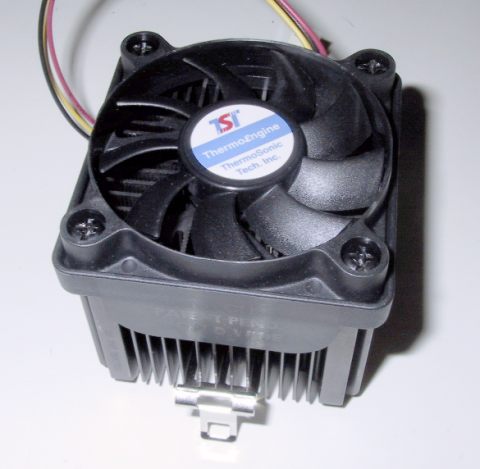
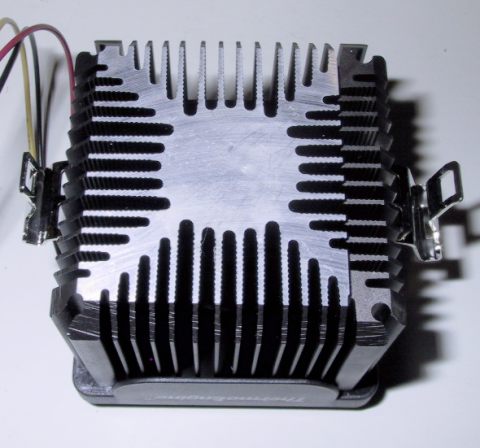
View from the back. With this cooler design, the air can flow freely through
the cooler, and not much air pressure builds up inside the heatsink (this
is a common problem with more "classic" designs).
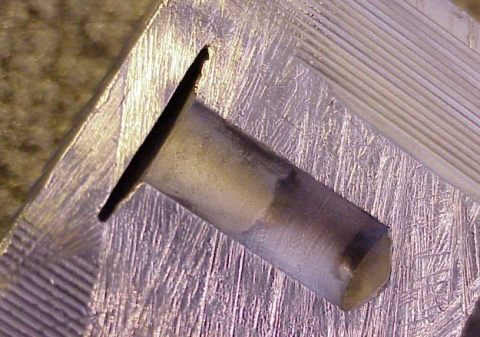
The Thermoengine is not only innovative on the outside! Apparently, it features
an embedded heat pipe, which provides excellent thermal transfer through the
center core. Image supplied by HardOCP
(used with permission).
Performance
The Thermoengine was the big surprise of this roundup. Even though it is relatively small, its performance is astonishing. With the standard fan, the cooling performance is OK, and the noise level is acceptable; but the Thermoengine really excels when used with the Delta 7000rpm fan. In this configuration, it outperformed even the Kanie Hedgehog (the performance winner of our last Socket A cooler roundup) and Global WIN's new copper heatsink, the CAK38.
The price of the Thermoengine is not know yet - and this is the factor that will determine whether the ThermoEngine is a good buy or not.
Installation
Installation is easy and straightforward. A screwdriver is required to install the clip.
| Thermosonic Thermoengine |
|
Fan:
YS Tech 60x60x10mm
Fan
rpm (measured): 4147
Price: unknown (cooler
not yet available on the market) |
| Advantages |
|
| Disadvantages |
|
Global WIN CAK38
A Global WIN heatsink made entirely of copper - that is a big surprise.
Before, GW had only been manufacturing aluminum coolers and didn't even
use copper inlays.
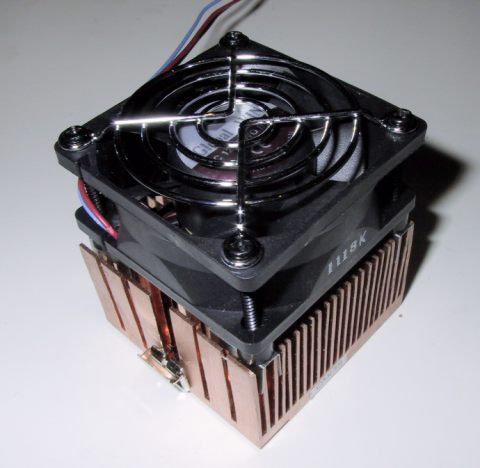
Performance
The CAK38's performance is good; it performs very close to the Kanie Hedgehog (the copper heatsink that performed the best in our last Socket cooler roundup). However, it is outperformed by the new Thermosonic ThermoEngine and the Alpha PEP66T - if these coolers are used with the same noisy 7000rpm fan. And of course the Swiftech MC462 - which pretty much is a class of its own - also outperforms the CAK38.
Global WIN has a tradition of offering high-performance coolers at very reasonable prices. The CAK38's price is still unknown - let's hope GW follows their tradition.
Installation
As all current Global WIN coolers, the CAK38's clip provides a very high pressure, and therefore is a little hard to install. We recommend to push down the clip with a screwdriver; this will make things easier.
Motherboard compatibility is very good; the CAK38 should fit all current motherboards.
Copper is heavy - and so is the CAK38. Keep this in mind when moving around your PC.
| Global WIN CAK38 |
|
Fan:
Delta "black label" 60x60x25
Fan
rpm (measured): 6898
Price: not yet known |
| Advantages |
|
| Disadvantages |
|
Global WIN WBK38
The Global WIN WBK38 is the FOP38's successor. Just like the FOP38, it features the same 7000rpm Delta fan, but a different heatsink design, with more - and finer - fins.
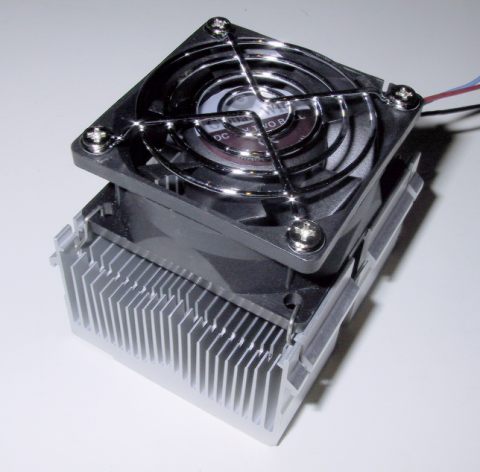
Performance
Even though the WBK38 looks more modern than its predecessor FOP38, it does not perform substantially better. Still, the performance is good - but the price for this is an excessively loud fan.
The price of the WBK38 is not yet known; since Global WIN usually offers their coolers at attractive prices, and since no exotic materials or manufacturing techniques are required for producing the WBK38, we can expect that it will have a very good price/performance ratio.
Installation
As all current Global WIN coolers, the WBK38's clip provides very high pressure, and therefore is a little hard to install. We recommend to push down the clip with a screwdriver; this will make things easier.
Motherboard compatibility is very good; the WBK38 should fit most current motherboards.
Unfortunately, GW ships the WBK38 with a thermal pad. This is really a nuisance; previous models came with thermal compound. For the test, we removed the pad and used compound. Probably the WBK38 is mainly targeted at OEMs; companies that usually prefer thermal pads over compound - since pads are more convenient for mass-production.
| Global WIN WBK38 |
|
Fan:
Delta "black label" 60x60x25
Fan
rpm (measured): 6898
Price: not yet known
(probably inexpensive) |
| Advantages |
|
| Disadvantages |
|
Vantec FCE-62540D
The Vantec FCE-62540D uses a very classical design; it looks like a larger version of the Global WIN FOP38.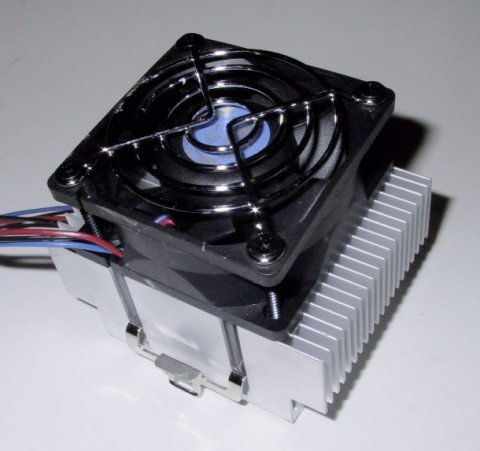
Performance
Even though the the FCE-62540D looks like an improved version of the Global WIN FOP38, it does not outperform the GW unit. Possible reasons for this could be the slightly lower rpm of the fan or the lower pressure of the Vantec clip.
Like all coolers equipped with 7000rpm fans, the FCE-62540D is excessively loud.
Installation
Installation is very easy - easier than with the Global WIN coolers, since the clip is not as strong, and has a more convenient handle.
| Vantec FCE-62540D |
|
Fan:
Delta 60x60x10
Fan
rpm (measured): 6687
Price: unknown |
| Advantages |
|
| Disadvantages |
|
TRIG / Adda T40-3
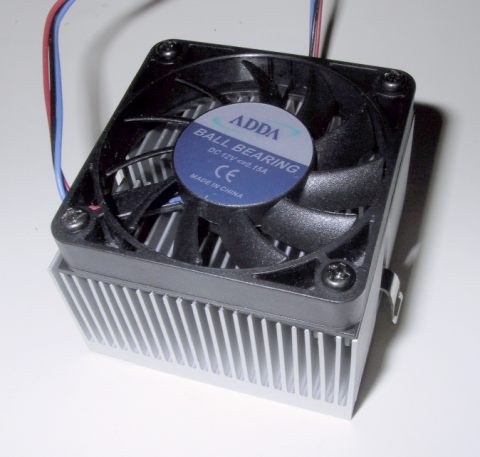
From above, the T40-3 looks as "normal" as it gets.
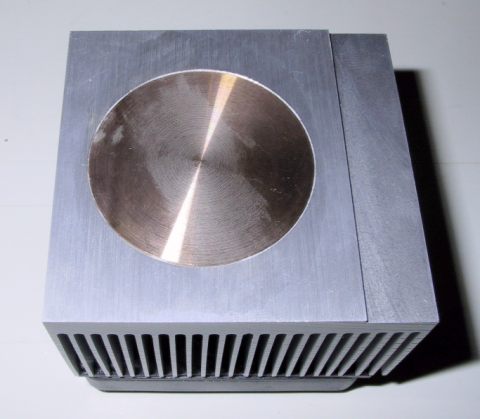
From below, the copper inlay becomes visible.
Performance
With its standard Adda 60x60x10mm fan, the T40-3 performed okay - especially considering the size - , but not particularly great. With the 7000rpm Delta fan used by Global WIN, the cooling performance was surprisingly good - it even outperformed the GW FOP38 and WBK38. This is astonishing, since these coolers are much larger. We suspect that it's the copper inlay that makes the difference.
Installation
The T40-3's clip comes without a handle; therefore a screwdriver is required for installation.
| TRIG / Adda T40-3 |
|
Fan:
Adda 60x60x10mm
Fan
rpm (measured): 4810
Price: unknown |
| Advantages |
|
| Disadvantages |
|
Conclusion
A lot has happened since our last cooler roundup: Swiftech outperforms all their competitors with the MC462 monster cooler, Global WIN introduces a copper heatsink, and two previously not so well-known manufacturers - Thermosonic and TRIG / Adda - provided samples of new coolers with astonishing performance. And let's not forget Alpha: The new version of the PEP66, the PEP66T, was also very convincing.
Which model should you chose? If you're using a Socket A CPU, and money is not an issue, go with the MC462.
If you're using an Intel CPU, and are looking for the best performance and don't care about noise, the Alpha PEP66T with Delta fan is your best choice.
Unfortunately, the prices of most of the new coolers reviewed here are not yet known. The Global WIN CAK38, the Thermosonic ThermoEngine, and the TRIC / Adda T40-3 are also worth considering - their performance is good, whether the price/performance ratio will be good remains to be seen. In the case of the ThermoEngine and the T40-3, the stock fan should be replaced by a more efficient fan if you're into overclocking.
Users who are worried about noise, and still want good cooling performance, should consider the Alpha PAL35 with Sanyo Denki fan. The Agilent ArctiCooler also offers good performance at a low noise level - but it still isn't available on the retail market, and we don't recommend it for AMD CPUs because of installation problems.
Manufacturer links
-
Swiftech (online ordering possible)
We do not provide information about where to buy the coolers tested here, since they are not yet available on the retail market







